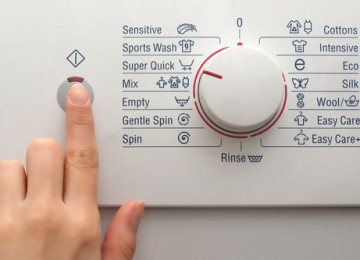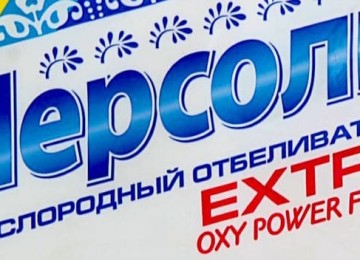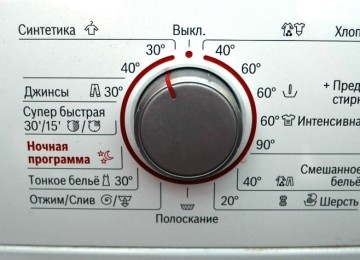If after the first wash the stain cannot be removed, many women stop wearing the item and throw it away. However, there are many effective ways to remove a stain on a dress using folk and specialized remedies.
.jpg)
Things to consider: how to remove stains correctly
To determine the cleaning method and not spoil the clothes, consider:
- the composition of the fabric from which the dress was made;
- product color;
- type of pollution.
In addition, when choosing a cleaning product, it is important how long ago the stain appeared on the dress.
Fresh contamination
It is better to start fighting pollution as soon as it appears. In this case, there is less risk that substances that get on the fabric will irreversibly change the color, fiber structure, etc. To remove a fresh stain, it is sprinkled with a natural absorbent that can absorb the pollutant.
These properties have:
- salt;
- starch;
- talc;
- chalk.
In addition, to remove fresh stains at home, a special product is often used, for the preparation of which 5 ml of ammonia is mixed with 1/2 tsp. salt.
Treat the contaminated part with this composition and leave for 5 minutes. Then the dress is rinsed. If necessary, the product is reapplied for the same period of time. In most cases, this is enough to eliminate contamination.
Sprinkle the greasy stain with washing powder and leave for 10 minutes. Then the item can be washed. Fresh traces of juice can be easily removed with a damp cloth.
.This treatment will prevent contamination from penetrating into deep fibers. After this, the dress must be washed taking into account the characteristics of the material from which it was made. Fresh dirt is removed from thick fabric with a brush.
Old stains
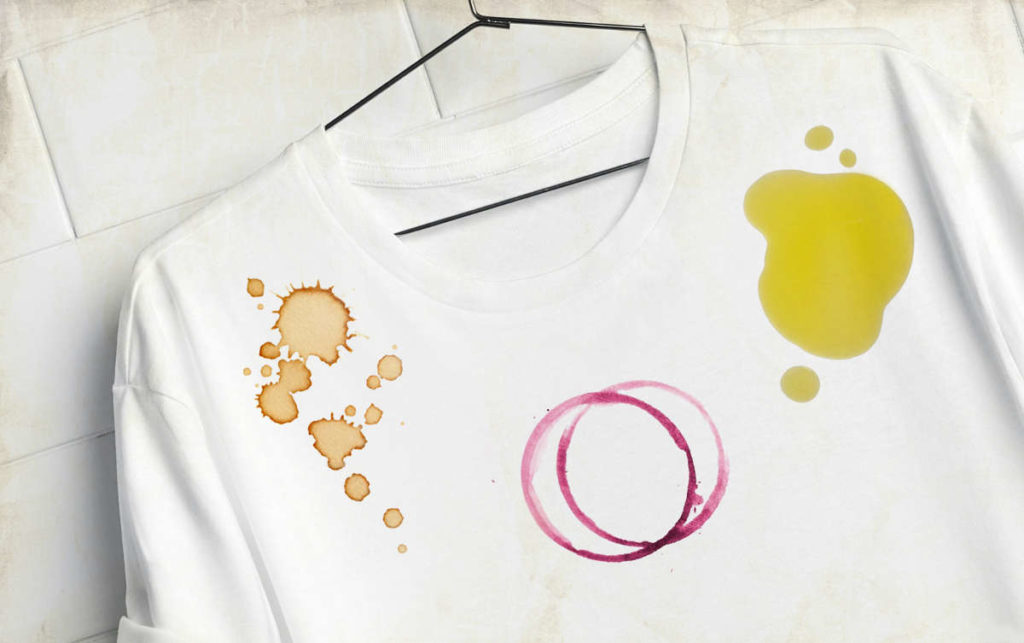
Old stains are much more difficult to remove. It is not always possible to preserve the color after removing them. In addition, due to the need to use folk remedies, there is a high probability of damage to the fiber structure, which will make it impossible to continue wearing the dress.
In this case, it is recommended to pre-treat the source of contamination with a strong stain remover.
Such means include:
- Bagi.
- Wide Haiter.
- Biomio.
- Dr. Beckmann.
- Udalix Oxi Ultra.
- Vanish Gold Oxi Action etc.
If there are traces of blood, juice, grass or fat on clothing, thoroughly rub the contaminated areas with soap. After this, the item is poured with hot water and left for 3–5 hours.
Features of cleaning different fabrics
When choosing a method for removing contamination, it is important to take into account the characteristics of the fabric. Some fibers withstand elevated temperatures and the influence of aggressive agents well, others require delicate cleaning, because... Improper care can cause damage to the fabric structure and loss of color.
Silk
Natural silk is quite dense, but at the same time light. When exposed to high temperatures, it sheds. The fabric is delicate, which makes stain removal difficult.
Below are the main rules for caring for silk clothing:
- When washing, use only special liquid cleaning products.
- To preserve color when rinsing, add vinegar to water in a ratio of 1:1000.
- Wash by hand at temperatures up to +30°C.
- The item is rinsed first in warm and then in cool water.
- The washed silk dress is wrapped in another cloth and wrung out.
- The product is spread on a horizontal surface for drying.
- A slightly damp dress is ironed from the wrong side.
If a yellow stain from sweat appears on white silk, it is removed with a special solution. To prepare the product, mix water and alcohol in a ratio of 1000:50.
To eliminate an old greasy stain, treat it with a mixture of 1 tbsp. glycerin, 1 tbsp. ammonia and 1 tbsp. distilled water. The composition is left on the fabric for 1 hour. Then the items are washed.
.jpg)
Velvet

A dress made of this material can easily be damaged if aggressive methods are used to remove contamination.
There are a number of mandatory rules for caring for velvet products:
- Wash by hand.
- When cleaning, rub the contaminated area lightly.
- Use only liquid formulations intended for velvet.
- The wet dress is placed on a towel and rolled to remove moisture and not stretch the fabric.
- The velvet is straightened with the pile up and dried on a horizontal surface.
- The product should only be stored unwrapped to prevent creases from occurring.
- Smooth the pile with a dry brush.
It is easy to remove only fresh dirt from velvet. To remove a grease or red wine stain, wipe it with a clean, lint-free cloth soaked in alcohol. After this, the product is washed.
Guipure
Guipure is a lightweight lace fabric. If the material is dense, even machine washing at low drum speed is acceptable. The lace, interspersed with large mesh inserts, is cleaned of dirt by hand.
Rules for caring for guipure dresses:
- Washable at temperatures up to +30°C.
- To remove stains, clothes are pre-soaked for 5 hours in a solution, for the preparation of which 10 tablespoons are dissolved in 10 liters of warm water. salt.
- Before washing, guipure dresses are rinsed.
- Rub the contaminated area with minimal force so as not to damage the lace.
- To give the fabric shine, add 1/3 tbsp to 10 liters of rinsing water. vinegar.
- Dry the item flat to prevent creases from forming.
Yellow spots often appear on white guipure dresses during long-term storage. To eliminate them, use a mixture of 20 ml of water, the same amount of ammonia and 5 g of salt.
It is used to treat contaminated areas and leave for 15 minutes. Then the dress is rinsed in running water. If the mark does not disappear, the product is reused.
.jpg)
Chiffon
Chiffon is a thin translucent synthetic fabric.It is difficult to remove any stain from it, because... contaminants are quickly absorbed into the fibers.

The main rules for cleaning chiffon dresses:
- Wash by hand at temperatures up to +35°C, without squeezing or twisting to avoid fiber breaks.
- Gentle liquid products are used for cleaning.
- The dress is rinsed in several waters to prevent streaks from appearing.
- To dry, hang the product on hangers.
- Chiffon is ironed with a steam generator.
There are some subtleties in removing difficult stains from chiffon. To remove oil stains, treat the contaminated area with a thick mixture of 1 tbsp. dishwashing detergent and 1 tsp. soda After 15 minutes, remove the remaining composition with a dry cloth. After this, the dress should be washed.
Removing stains from tea, red wine, and rust from chiffon is more difficult. To remove dirt from fabric fibers, use citric acid.
To prepare the cleaning product, 1 tbsp. This substance is poured into 1 liter of boiling water. The contaminated area is immersed in the solution for 3 minutes. The product is then washed in the standard way.
Staple
In the production of staples, a combination of natural and synthetic fibers is used, so after washing there is a high probability of shrinkage. It is permissible to clean dresses made from this type of fabric both manually and in a machine in a mode with a minimum intensity of drum rotation.
The main rules for caring for dresses made from staples:
- Washable in water at temperatures up to +40°C.
- The powder is selected taking into account the color of the dress.
- Special agents are added to the water to prevent fabric shrinkage.
- Old stains are cleaned with a soft bristle brush.
- Clothes from the staple are wrung out carefully so as not to damage the fibers.
- The product can be dried both vertically and horizontally.
Staple is a fairly resistant fabric, so to remove old stains, the dress must be pre-washed. Pour 5–10 g of powder onto the contaminated area, rub thoroughly and leave for 15 minutes. Then the product is washed.
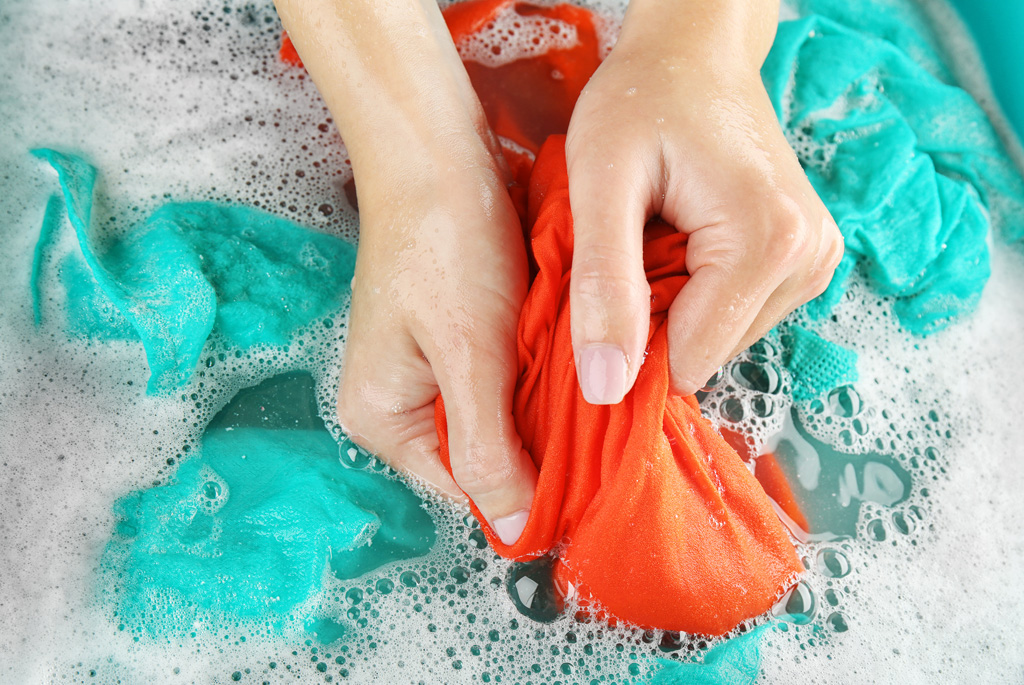
Polyester

Polyester dresses are lightweight and dry quickly.
The fabric does not absorb moisture well, so stubborn stains rarely appear on it.
The main rules for cleaning polyester clothing:
- Wash by hand or machine at +30°C...+40°C to prevent wrinkles.
- When cleaning, do not use products containing chlorine.
- An antistatic agent is used when rinsing.
- The dress is dried in a vertical position.
- The fabric is not ironed.
- If necessary, a steam generator is used to remove wrinkles.
If stubborn dirt appears on the dress, use special stain removers. Aggressive folk remedies are not used for cleaning polyester clothing, because... this will cause the fabric to fade.
Knitwear
Knitted dresses with additional elements made of leather, fur, leatherette and other materials are washed by hand. Cleaning in the machine is carried out only if there are no inserts.

Main rules of care:
- Knitted dresses can be washed at +40°C.
- An antistatic agent is used when rinsing.
- The clothes are wrung out carefully, because... Tightening too hard will cause the fibers to break.
- A knitted dress is dried flat.
- Iron the product through damp gauze.
Please note that the temperature of the rinsing water should not exceed +40°C. When washing knitwear, not only special stain removers are used. If you need to remove blood from the fabric, wash the contaminated area with laundry soap.
To remove chocolate stains, knitted clothes are soaked for 30 minutes in a product, for the preparation of which 15 tablespoons are added to 10 liters of warm water. salt.
This preliminary preparation will lead to the dissolution of the contamination. If traces of makeup appear on the dress, they are rubbed off with a clean, lint-free material soaked in alcohol.
Wool
Wool is a natural fabric that hardly wrinkles. It is better to remove dirt from it immediately, because if it penetrates into the deeper layers of the fibers, it will be more difficult to remove them.
To avoid pilling on a wool dress, it is recommended to follow the basic rules for caring for clothes made from this material:
- Wash wool products by hand or in a machine at water temperatures up to +30°C.
- They use special powder and additives that maintain the softness of the fabric.
- The dress is rinsed in several waters to remove any remaining detergent.
- Wool products are not twisted.
- To remove excess moisture, wrap the item in a terry towel and gently wring it out.
- The dress is dried on a horizontal surface.
- Woolen fabric is ironed through damp gauze.
White items made from this material often develop stains during long-term storage. They are pre-moistened and rubbed with laundry soap. After 1 hour the item is washed.
When using this method, pay special attention to rinsing to avoid streaks. Change the water several times to remove soap residue.
To remove stubborn dirt from fabric, use a mixture of 20 ml of glycerin, 200 ml of warm water and 10 ml of ammonia. Treat the stain with this mixture and leave for about 15–20 minutes. Then the product is washed.
.jpg)
Cotton
Cotton dresses are lightweight and breathable.Stains quickly eat into the fibers. At the same time, the fabric washes well. When cleaning it, you can even use aggressive agents, incl. containing chlorine.
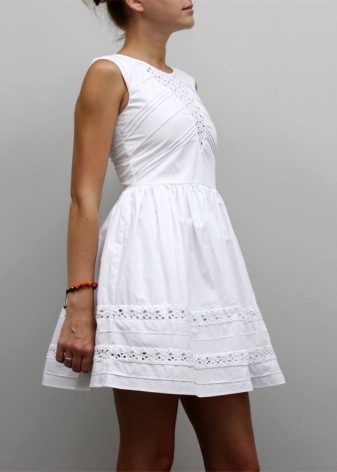
Rules for caring for clothes made from this material:
- Cotton dresses are machine washed at water temperatures up to +60°C...+95°C.
- Cotton should not be washed together with synthetics to avoid pilling.
- Colored dresses are washed with special powders.
- Several waters are used for rinsing.
- Cotton products are twisted as carefully as possible to avoid breaking the fibers.
- The dress is dried flat.
- Slightly damp cotton is ironed with an iron heated to +200°C.
White dresses are thoroughly rinsed in cold water so that no streaks remain on them. Heavily soiled clothing made from this material is boiled.
Linen
Linen dresses are good for summer because... The fabric is breathable and dries quickly. If not properly cared for, the material shrinks or becomes hard.

There are some subtleties of cleaning linen clothes:
- The product is soaked to reduce the risk of shrinkage.
- The dress is machine washable at temperatures up to +95°C.
- When cleaning colored items, do not use powders containing bleach.
- Linen clothes are rinsed in cool water.
- The dress is straightened and dried in the open air.
- The fabric is ironed through gauze with a very hot iron.
To remove greasy stains from flax, folk remedies based on ammonia, salt and soap are used. These substances are taken in equal proportions and mixed.
The contaminated part is treated with the composition. Then the item is thoroughly rinsed in several waters. This will help avoid streaks on the fabric. Boiling is also allowed.
Jeans
Jeans are quite thick, and stubborn stains are difficult to remove.
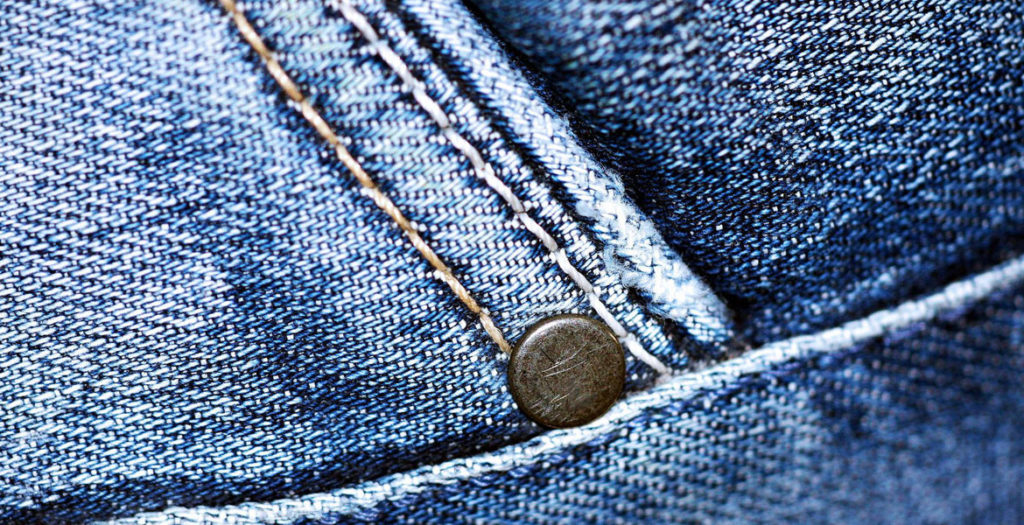
Basic rules for caring for denim clothing:
- The dress is machine washed at a water temperature of no more than +40°C.
- Use powders for colored items without bleaching additives.
- Rinse the dress thoroughly in cool water.
To remove greasy stains from denim, use not only stain removers, but also folk remedies based on vinegar and hydrogen peroxide. Mix these components in equal proportions. Apply the composition to the contaminated areas and leave for 60 minutes. After this, wash the dress using the standard method.
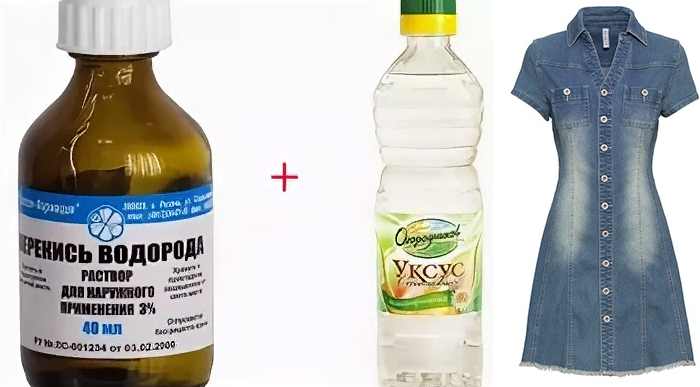
Removing stains from difficult items
Removing stubborn stains from some items is particularly difficult. The use of strong cleaning agents is unacceptable, as this will damage the product.
Black dress with a white collar
When washing such a dress, there is always a risk of stains appearing on the white collar. Some models provide the ability to remove this element.
If the collar cannot be unfastened, the dress is washed in cool water, the temperature of which should not exceed +30°C. The product must be rinsed well.
To reduce the risk of stains on the white collar, this part is sprayed with ethanol, hydrogen peroxide or aspirin solution.
To remove ingrained dirt, treat the contaminated area with a stain remover or folk remedy. Then the dress must be washed, taking into account the cleaning features of the type of fabric from which it is sewn.
Knitted
A knitted dress is washed by hand in water up to +40°C. Strong friction of individual areas is unacceptable, since this will lead to stretching and loss of the appearance of the product.
If the dress is heavily soiled, it is pre-treated with a special stain remover and left for 30 minutes in warm water.
In some cases, folk formulations are also used to remove greasy stains. When choosing a product, take into account the type of thread used in the manufacture of clothing.
Pre-soaking will help remove dirt embedded in deep fibers and remove stains. This product is rinsed in several waters.
Knitted dresses cannot be twisted. To remove excess liquid, wrap the item in a terry towel. After this, it is straightened and laid out to dry on a horizontal surface.
.jpg)
With decor
Evening and cocktail dresses are often decorated with sparkles and rhinestones. These clothes are washed by hand. The stain remover is applied locally, treating only contaminated areas.
The product is thoroughly rinsed in cool water. It is wrung out gently using a terry towel. The outfit is dried flat on a horizontal surface.
Prone to fading
Such dresses are washed by hand at water temperatures up to +30°C. In this case, powders are used for colored laundry. To remove stubborn stains, it is recommended to use special stain removers.
Features of removing different types of stains from dresses
The choice of product depends on the type of contamination. Some substances can be easily removed with water, while others require the use of aggressive chemical solvents.
Acrylic paints
Acrylic paints wash off well from most types of fabrics. In this case, part of the substance may remain in the fibers, leading to the appearance of an untidy stain.
To remove traces of acrylic paint, place a cloth napkin under the wrong side of the contaminated area.A cotton pad is generously dipped in nail polish remover that does not contain acetone.
The contamination is soaked through a napkin. Leave the treated fabric for 15 minutes. This time is enough to dissolve the contamination.
Then wipe the fabric with a clean cotton pad. If the mark does not disappear, you should repeat the procedure. When the stain is removed, the dress must be washed.
To remove old traces of acrylic paint, first thoroughly clean the stain with a soft brush. This will help remove any hardened material remaining on the surface.
The mark is moistened with water, sprinkled with washing powder and rubbed into the fabric with a toothbrush. The procedure is carried out carefully so as not to damage the fibers. After pre-treatment, the clothes are washed in the standard way.

Pencil
If the fabric is thick and a barely noticeable pencil stain appears on it, use a school eraser to remove it. Often this is enough. If the fabric is thin or loose, place a napkin under it.
Then the cotton pad is soaked in White Spirit solvent. Use it to thoroughly wipe the stain. After pre-treatment, the dress needs to be washed.
Rusty traces
Traces of rust are extremely difficult to remove from most types of fabric. Such contamination is especially dangerous for white things. To remove the stain, cut off a piece of lemon and wrap it in a napkin.
It is applied to the contaminated area and pressed against the fabric with a heated iron. This helps oxidize the rust and remove it. After such preliminary preparation, the dress must be washed taking into account the characteristics of the fabric.
To remove rust stains, a composition is also used, for the preparation of which 1 tbsp. citric acid is diluted in 1/2 tbsp. water.The solution is applied to the contaminated area for 15 minutes.
If yellow spots appear on a white dress due to the high iron content in the water, the product is soaked in 5 liters of liquid, to which 5 tablespoons are added. citric acid. Then rinse the item in filtered water. To remove traces of rust from thick fabric, the procedure often has to be repeated several times.
.jpg)
Glue

It is quite difficult to remove superglue from a dress, because... mechanical impact will damage the fibers. This stain is pre-dissolved. It is soaked in acetone and left for about 10–15 minutes.
The separated glue is removed with a dry cloth. This method is recommended to be used with caution because... acetone may discolor or damage the fabric.
PVA stains are easier to remove. The film that has frozen on the surface is carefully removed to prevent damage to the fibers.
To remove the remaining white stain, a cotton swab is soaked in ammonia, applied to the stain and pressed down with any heavy object. After 15 minutes, rub the stain with laundry soap. After this pre-treatment, the dress needs to be washed.
Paraffin
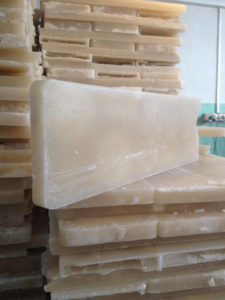
Drops of paraffin leave greasy marks on the fabric. This substance hardens quickly, so most of it is easy to remove. To remove the stain, place the item between 2 clean sheets of thick paper.
Then the product is ironed with a hot iron. Under the influence of high temperature, the paraffin residues present in the fibers of the fabric will fall onto the paper. If a mark remains, rub it with soap. After 2 hours, the product is washed in a standard cycle.
Grass juice
Traces of grass are difficult to remove, because... chlorophyll is a persistent pigment. To eliminate it, alcohol-containing products are used.They quickly destroy pigment and help remove even old stains.
A cotton swab is moistened with medical alcohol and rubbed over the contaminated area. This procedure is carried out until there is no longer a greenish trace left on the cotton wool.
You can pour a little of this substance onto fabric made from natural fibers. When cleaning dresses made of synthetic materials, this method is used with caution.
If contamination remains, the stain is additionally treated with dishwashing detergent. After this pre-treatment, the dress is washed.
In addition, to remove old marks, a composition is used, for the preparation of which 1 tbsp is mixed. water, ammonia and hydrogen peroxide. Treat the stain with this mixture and leave the item for 3 hours. Then the clothes are thoroughly rinsed and washed in hot water.
To remove grass stains, use 1 tbsp. washing powder, 1 tbsp. soda and 1 tsp. water. These components are thoroughly mixed. Rub the composition into the stain and leave the item for 2 hours. Then the dress is rinsed well.

Ink
The ink is highly fluid, so it quickly absorbs into the deep layers of the threads, coloring them. To remove such stains, aggressive agents are used.
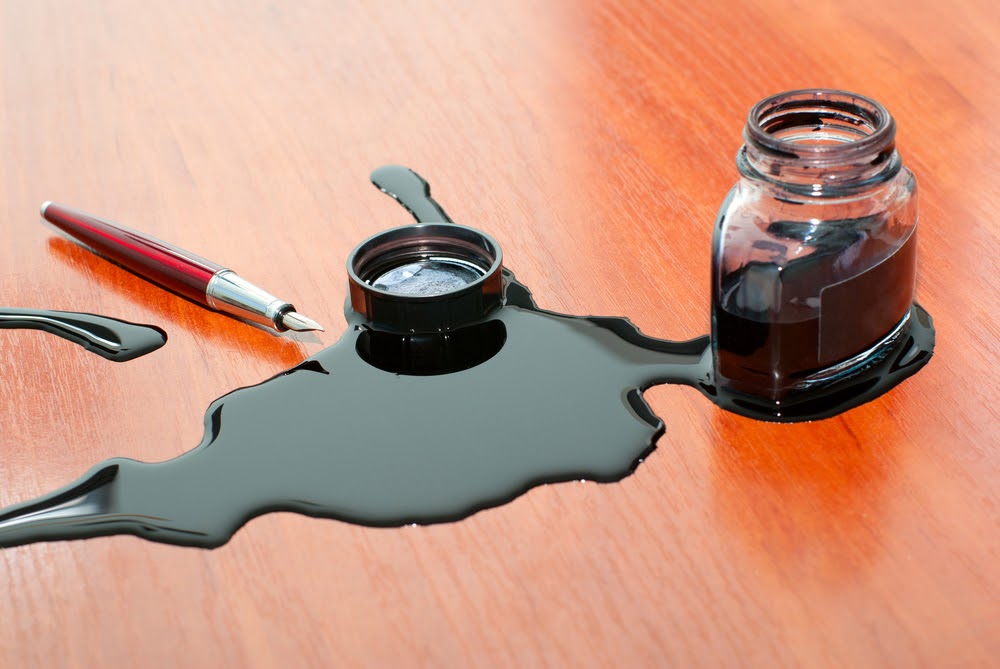
In a separate container, mix ammonia and wine alcohol in equal proportions. Then lightly soak the area of contamination with the resulting mixture. After 15 minutes, the remaining mark is treated with a stain remover. After this, the dress can be washed.
If ink has recently come into contact with clothing, use lemon juice. They treat the contaminated part for 10 minutes. After this, the item is washed in water at the maximum permissible temperature.
Chalk
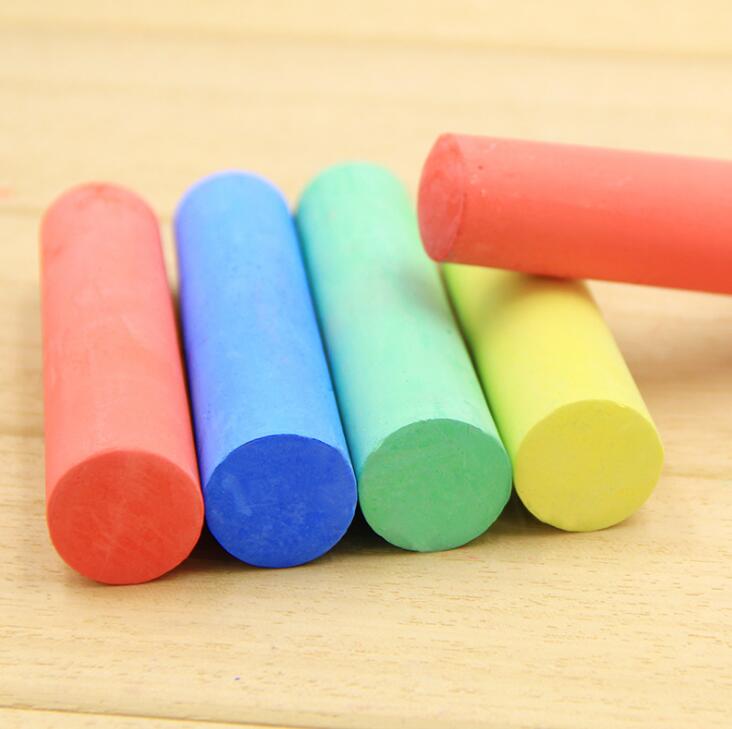
To eliminate traces of chalk, first of all, carefully wipe out the dress or vacuum it. This will help eliminate small particles of the substance. A cotton swab is moistened with rubbing alcohol and wiped over the stain. Then the dress is thoroughly rinsed in 10 liters of water with the addition of 5 tbsp. vinegar.
Oil
To remove vegetable oil stains from a dress, you will need starch. A piece of white cloth is placed under the wrong side of the fabric. Then the contaminated area is sprinkled with starch, preheated in a clean frying pan.
Place a sheet of paper on top and press it with any weight. The dress is left in this position for 20 minutes. Then remove the load and brush off the starch with a brush.
Kerosene is used to remove machine oil from dresses. This substance is poured onto the stain. Then it is collected with a dry cloth, moving from the periphery of the contaminated area to the center. This will help avoid streaks. Then the clothes are washed. The method is used to clean products made from natural fabrics.
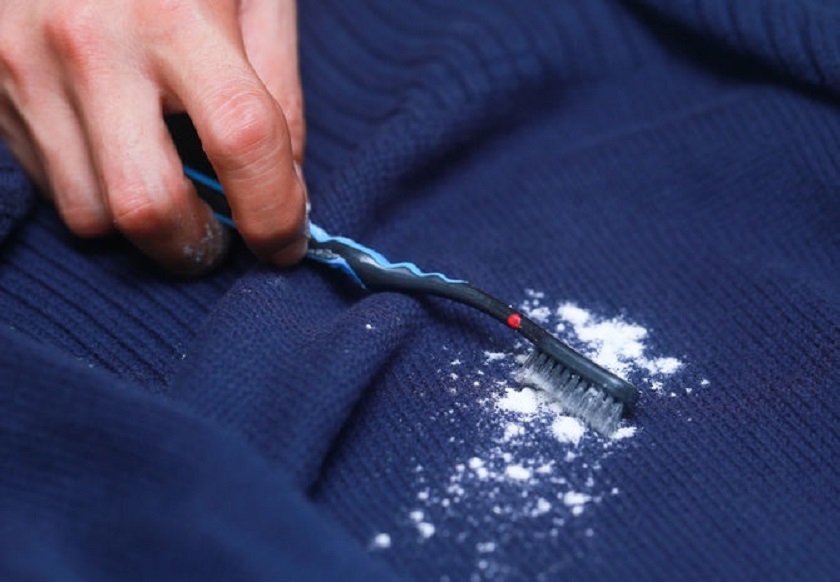
Blood
Hydrogen peroxide is used to remove traces of blood from a dress. Soak a cotton pad in it and wipe the contaminated area with it until the sponge stops turning brown. Then the dress is rinsed in cool water. If the mark does not disappear, the procedure is repeated.
To remove blood stains from white dresses, a composition of sodium tetraborate and hydrogen peroxide mixed in a ratio of 1:20 is often used.
The product is applied to the stain. After 3 hours, the item is washed in the standard way.
A small fresh blood stain can be removed with an ice cube. You need to place a napkin under the fabric. Rub the cube over the contaminated area, pressing lightly. Take short breaks every 30 seconds, leaving ice on the fabric.This method is especially effective for removing blood stains from synthetic dresses.
Chlorine
If chlorine gets on a colored material, wash it off immediately with plenty of water. This substance is aggressive. Under its influence, the fabric can quickly lose its color.
If time has been lost to save the dress, soak a cotton pad in ethyl alcohol and wipe the contaminated part of the product. The item is washed taking into account the characteristics of the fabric.
Stains from berries and fruits
To remove traces of fruit or berry juice, pour water into a saucepan and bring it to a boil. Keep the contaminated fabric under steam for 10 minutes. Mix vodka and lemon juice in equal proportions in a separate container.
Treat the area with this product. After 10 minutes, moisten the stain with ammonia mixed with water in a ratio of 1:2. Then wash the clothes in a soap solution at the maximum permissible temperature. Felt-tip pen

Felt-tip pen stains are removed with ammonia. The contaminated area is soaked in this substance and rubbed with a sponge. In a separate container, rub 1 tbsp. of laundry soap and mix it with 1 tbsp. of hot water until a homogeneous mass is obtained. Treat the stain with it and leave the dress for 1 hour. After this, the item is washed.
Wine
If a wine stain appears on clothing, measures should be taken to remove it as quickly as possible. Sprinkle the stain with a small amount of salt, cover with a napkin and press down with a heavy object.
This substance will act as an absorbent and absorb most of the pigment. After about 10-15 minutes, the dress must be washed in hot water.
.png)
If the wine stain was discovered too late, use a product based on citric acid. To prepare it, dissolve 1 tsp. of the substance in 1 tbsp. of warm water.This method is especially effective for removing blood stains from synthetic dresses.
Bleaching
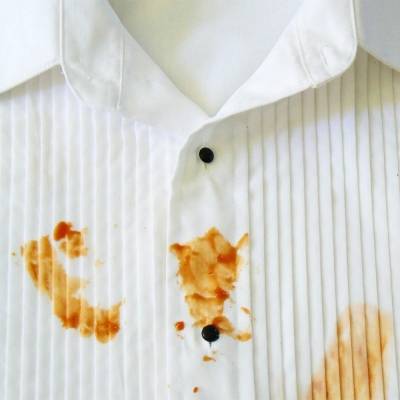
If bleach gets on colored material, wash it off immediately with plenty of water. This substance is aggressive. Under its influence, the fabric can quickly lose color.
If time has been lost to save the dress, a cotton pad is moistened in ethyl alcohol and the contaminated part of the product is wiped. The item is washed taking into account the characteristics of the fabric.
Traces of berries and fruits
To remove traces of juice from fruits or berries, pour water into a saucepan and bring it to a boil. The contaminated fabric is kept under steam for 10 minutes. In a separate container, mix vodka and lemon juice in equal proportions.
The area is treated with this product. After 10 minutes, the stain is moistened with ammonia mixed with water in a ratio of 1:2. Then the clothes are washed in a soap solution at the maximum permissible temperature.
Felt pen
Marker stains are removed with ammonia. The contaminated area is impregnated with this substance and rubbed with a sponge. Rub 1 tbsp into a separate container. laundry soap and mix it with 1 tbsp. hot water until smooth. The mark is treated with it and the dress is left for 1 hour. After this, the product is washed.
Wine
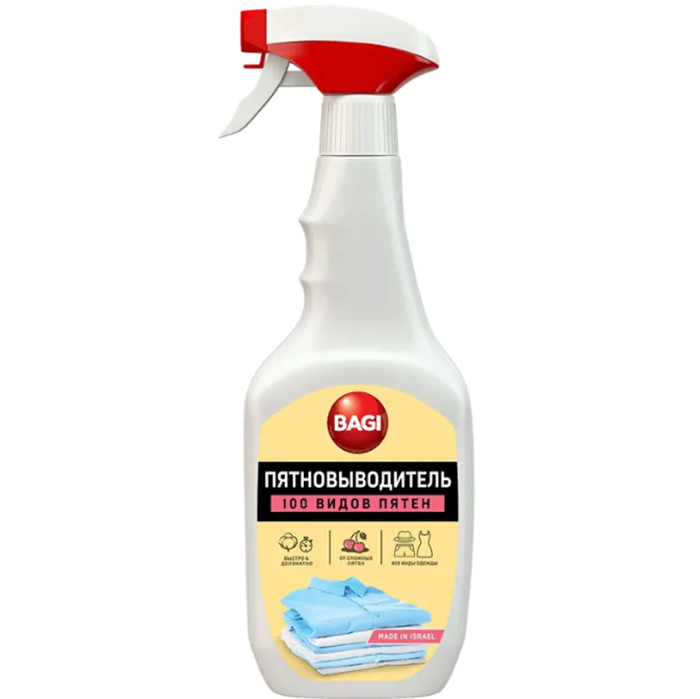
If a wine stain appears on your clothing, you should take steps to remove it as quickly as possible. The mark is sprinkled with a small amount of salt, covered with a napkin and pressed down with a heavy object.
This substance will act as an absorbent and absorb most of the pigment. After about 10–15 minutes, the dress should be washed in hot water.
.png)
If the trace of wine was discovered too late, use a citric acid-based product. To prepare it, 1 tsp. substances are dissolved in 1 tbsp. warm water.Moisten the area of fabric on which the stain appears in the mixture and leave the item for 1 hour. Then the dress is rinsed in cool water.
Fat
To remove a greasy stain, cover it with 3 layers of porous clean paper. Place a heated iron on top of it for 1 minute. Then the paper is removed and the clothes are washed in a standard mode.
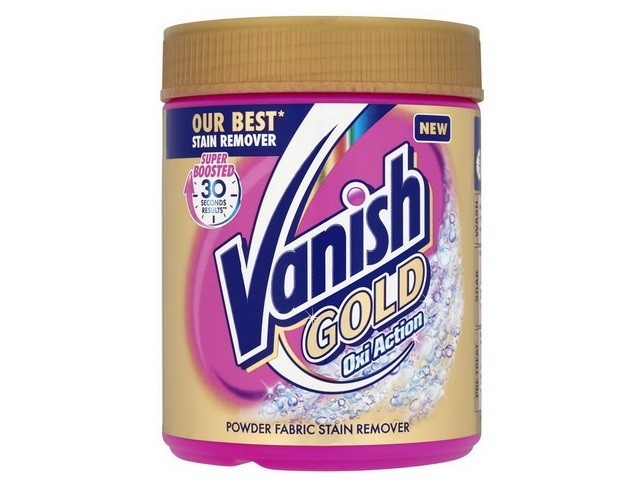
If a trace remains, it is treated with gasoline. This helps break down fat embedded in the fibers of the fabric. After this, the product is rinsed and washed with stain remover.
Sweat
Yellow marks from sweat can be removed with citric acid. To prepare the product, 150 g of the substance is diluted in 1 liter of water. This mixture is put on fire and heated to +70°C. Afterwards, the contaminated area of the dress is dipped into the resulting composition for 5 minutes. After removing the stain, the dress must be washed.
Zelenka
Hydrogen peroxide is used to remove traces of brilliant green. The product is poured generously onto the stain. After 1 hour, this area is soaped. The dress is then washed thoroughly in hot water. If the fabric is thick, use acetone to remove the brilliant green. They treat the stain and leave the clothes for 10 minutes. Then the item is thoroughly rinsed.
The best household chemicals for removing stains from delicate fabrics
Aggressive folk remedies can destroy the fiber structure, so they should not be used for cleaning delicate fabrics. In this case, to avoid irreversible damage to the dress, it is better to use special household chemicals.

Bagi
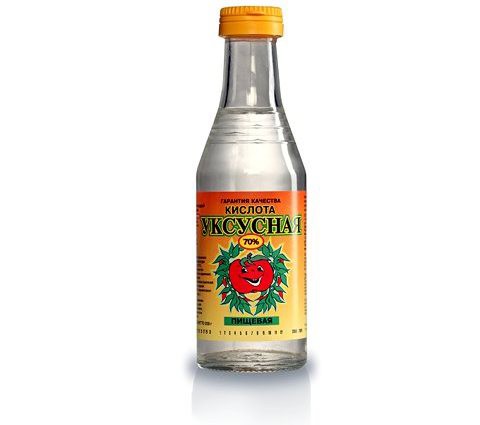
A powerful stain remover that is effective against more than 100 types of stains. The product is convenient to use, because Available in spray form, which can easily be used to treat an area of any size. Works especially well on fresh stains. Price – 350 rub.
Biomio
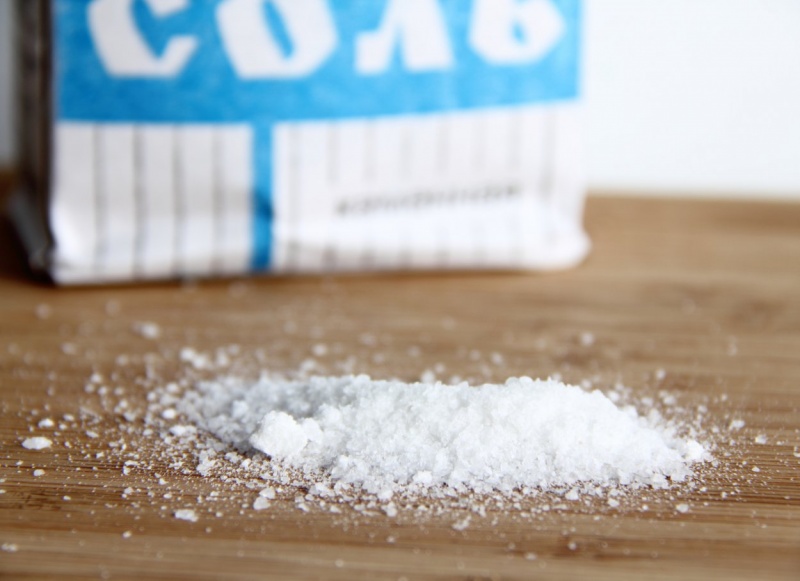
The universal product does not contain chlorine or other aggressive substances. It can be used to remove stains of varying degrees of complexity. The product is recommended for cleaning clothes made from delicate fabrics. Price – 320 rub.
“Plik”
An effective stain remover recommended for removing stains from paint and solvents. The product can be used to clean most types of fabrics. Price – 400 rub.
Vanish Gold Oxi Action
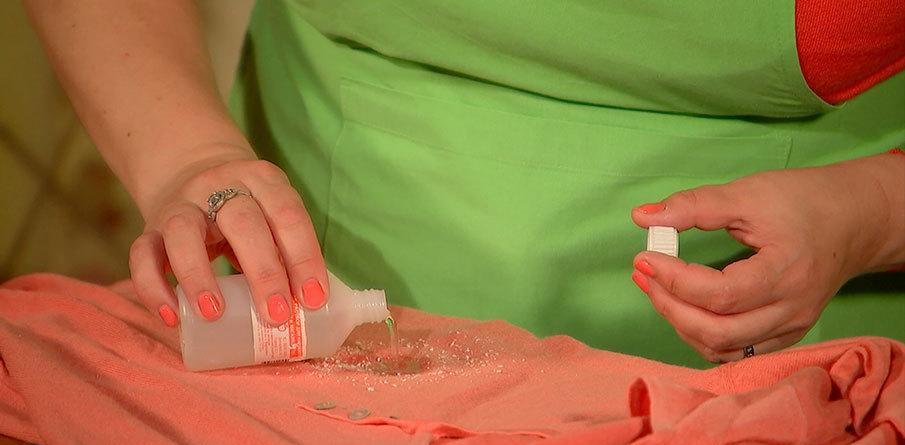
The stain remover can be used to remove even complex old stains. It does not contain chlorine or other aggressive substances. Price – 320 rub.

“Dry Es”
This stain remover comes in spray and powder form. It does not contain chlorine, alcohol and other aggressive substances, but is still effective. The product does not damage the tissue structure. Price – 450 rub.
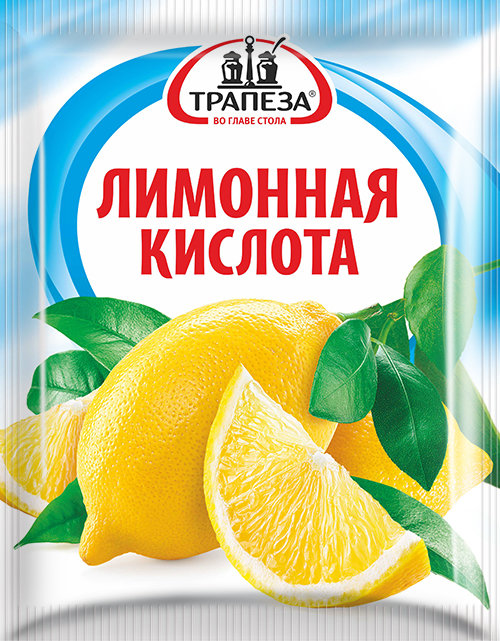
What folk remedies can be used
Homemade cleaning compositions are often no less effective than special household chemicals. However, they should be used with extreme caution, because... they are quite aggressive and can damage fabric fibers.

Soda
Baking soda is used to remove yellow stains from fat and sweat. In addition, it removes unpleasant odors. Soda is diluted with water to a mushy state, the contaminated area is treated with it and the dress is left for half an hour. Then the clothes are washed in soapy water.
Vinegar
This substance will help remove stains from juice, wine and sweat from thick fabrics made from natural fibers. Vinegar is diluted with water in a 1:1 ratio. Soak the dress in this solution for 6–8 hours. Then rub the stain with laundry soap. The dress is thoroughly rinsed and washed in the standard way.
Salt
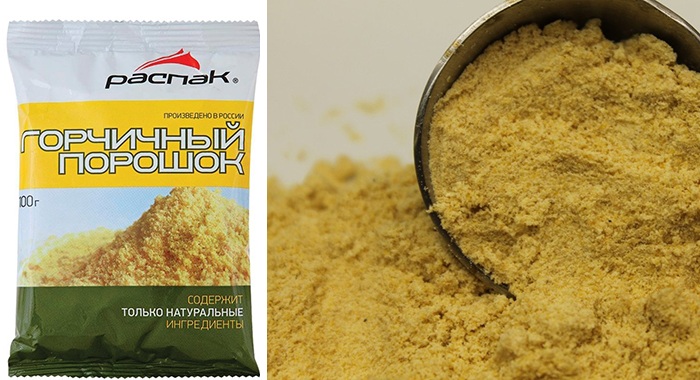
Table salt is used to remove sweat stains from white clothes.The contaminated part is moistened and sprinkled with this substance. The dress is left in this state for 2 hours. Then wipe the stain with a clean sponge. The product is rinsed.
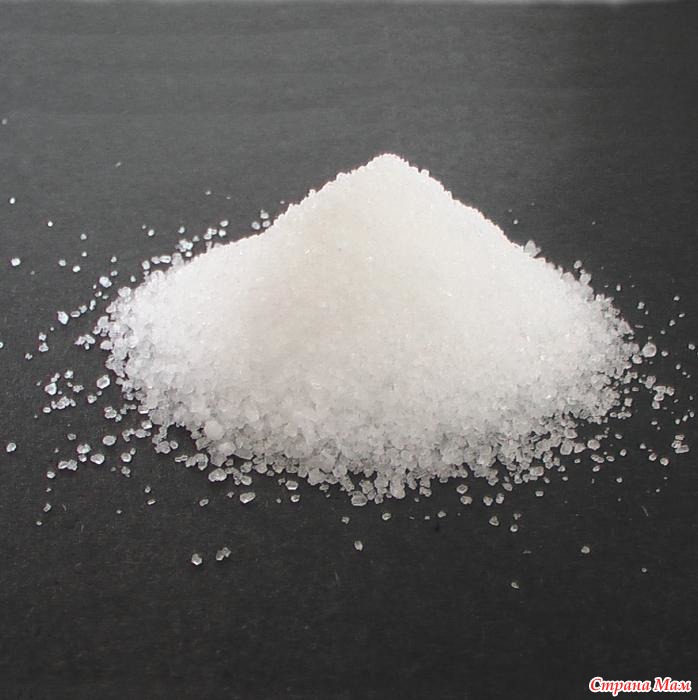
Peroxide
The substance copes well with stains from blood, juice, fat and sweat. In addition, hydrogen peroxide has a mild whitening effect. To remove contamination, the dress is soaked in a solution of 2 tbsp. peroxide and 10 liters of water.
To enhance the effectiveness of the product, add 2 tbsp. washing powder and 8 tbsp. salt. The dress is soaked for 4 hours. The product is then cleaned in the standard way.
Aspirin
Aspirin is recommended for removing yellow stains on white clothes. To prepare the solution, take 1 tablet per 1 liter of water. The medicine is crushed and then added to the warm liquid. The item is soaked in the solution for 12 hours and then washed.
Lemon acid
Citric acid is good at removing sweat stains. To remove fresh dirt 1 tsp. substances are dissolved in 100 ml of water. Then the desired area is treated with this product. After 30 minutes the dress is washed.
- Ammonia
- Ammonia is used to remove stubborn stains. To prepare the solution, 5 tbsp. The substances are mixed with 5 liters of warm water. The dress is soaked in it for 5–6 hours and then washed.
- To remove old stains, use a product that is prepared by mixing 4 tsp. glycerin and 1 tsp. ammonia. Treat the contaminated area with the composition and leave the dress for 1 hour. The product is washed off with plenty of water.
- Dry mustard
- The substance is used to remove stains from berries, grass, ketchup, wine and chocolate. First 1 tbsp. mustard is dissolved in 10 liters of water. Additionally, add 1 tbsp to the mixture. ammonia.
- Soak the dress in the detergent for 3 hours. Then the stain is thoroughly treated with laundry soap and left for another 60 minutes. After this, the item can be washed.
Sodium thiosulfate
Sodium thiosulfate is used to gently remove stains from silk and other delicate fabrics. An ampoule of dry powder must be dissolved in 200 ml of water.
Soak a cotton swab in the mixture, apply it to the desired area and leave the stain to soak for about 15–20 minutes. After this time, the item is thoroughly rinsed. If a trace remains, the treatment is repeated.
Alcohol
Alcohol is good at removing grease stains, grass juice and other stubborn stains. Ethanol is diluted with water in a 1:1 ratio. After about 20 minutes, the item is rinsed well and washed.
Alcohol is used with caution to clean dresses made of synthetic fabric, because... in this case, there is a high probability of color loss. Before use, you should test the product on a small and inconspicuous area.







